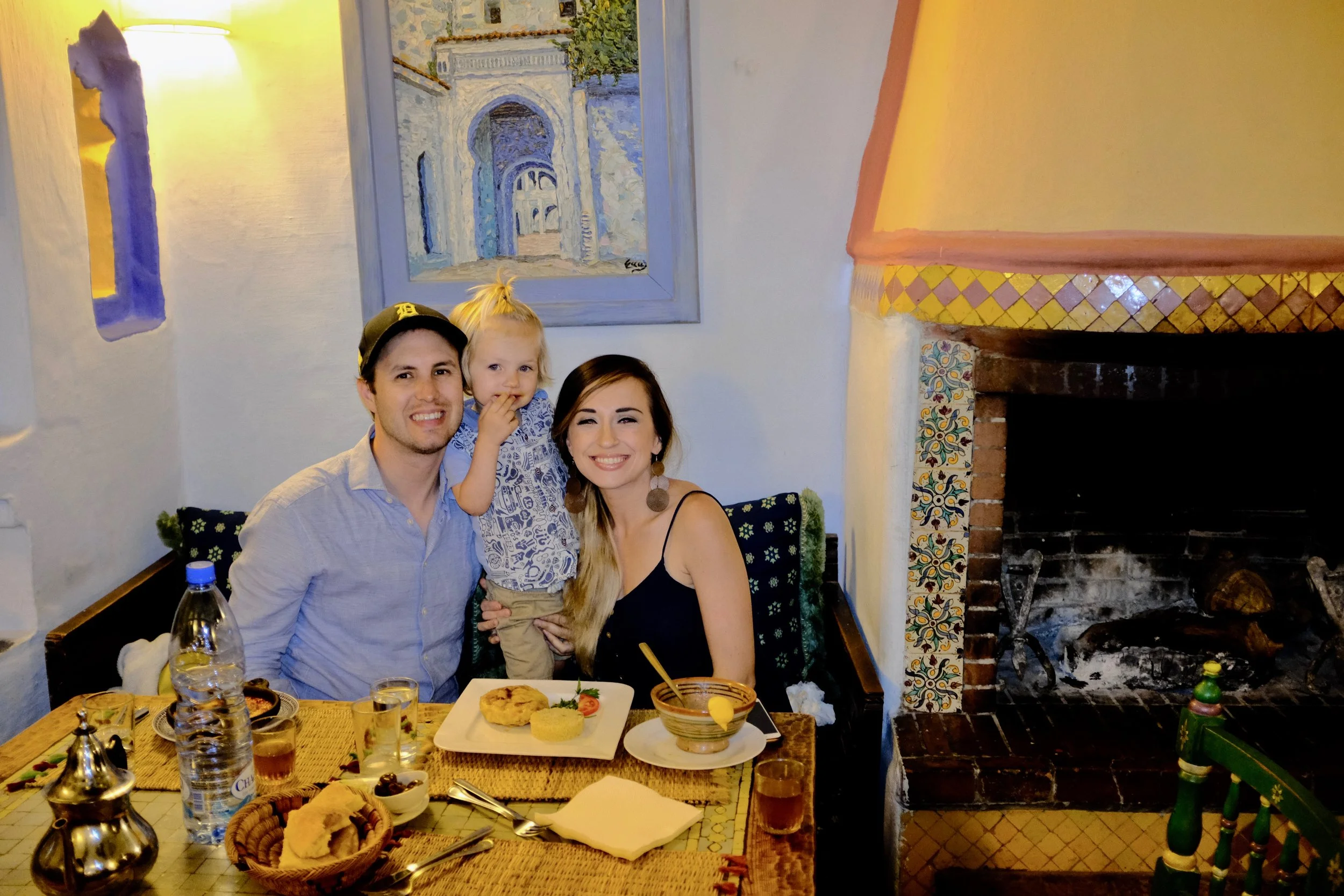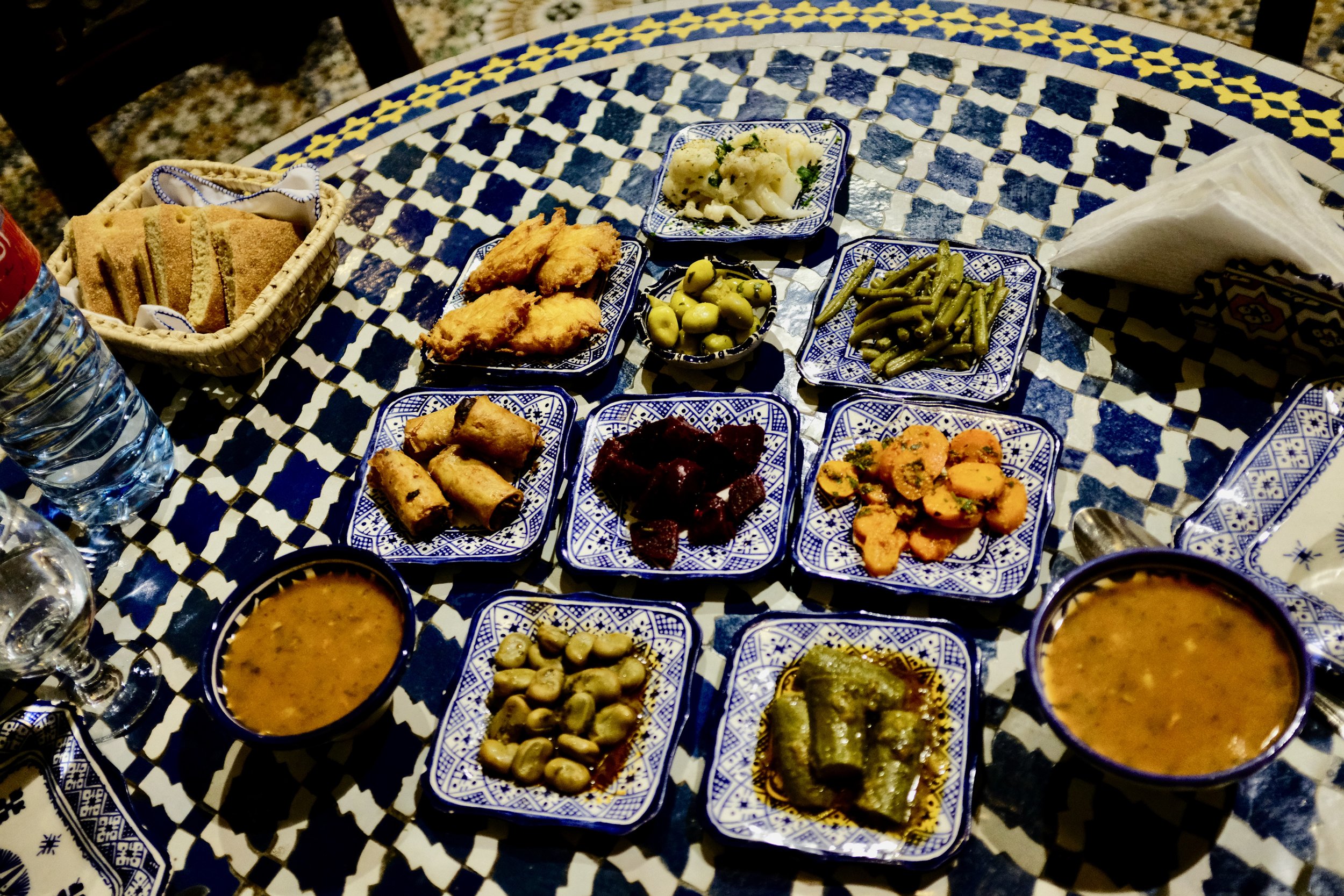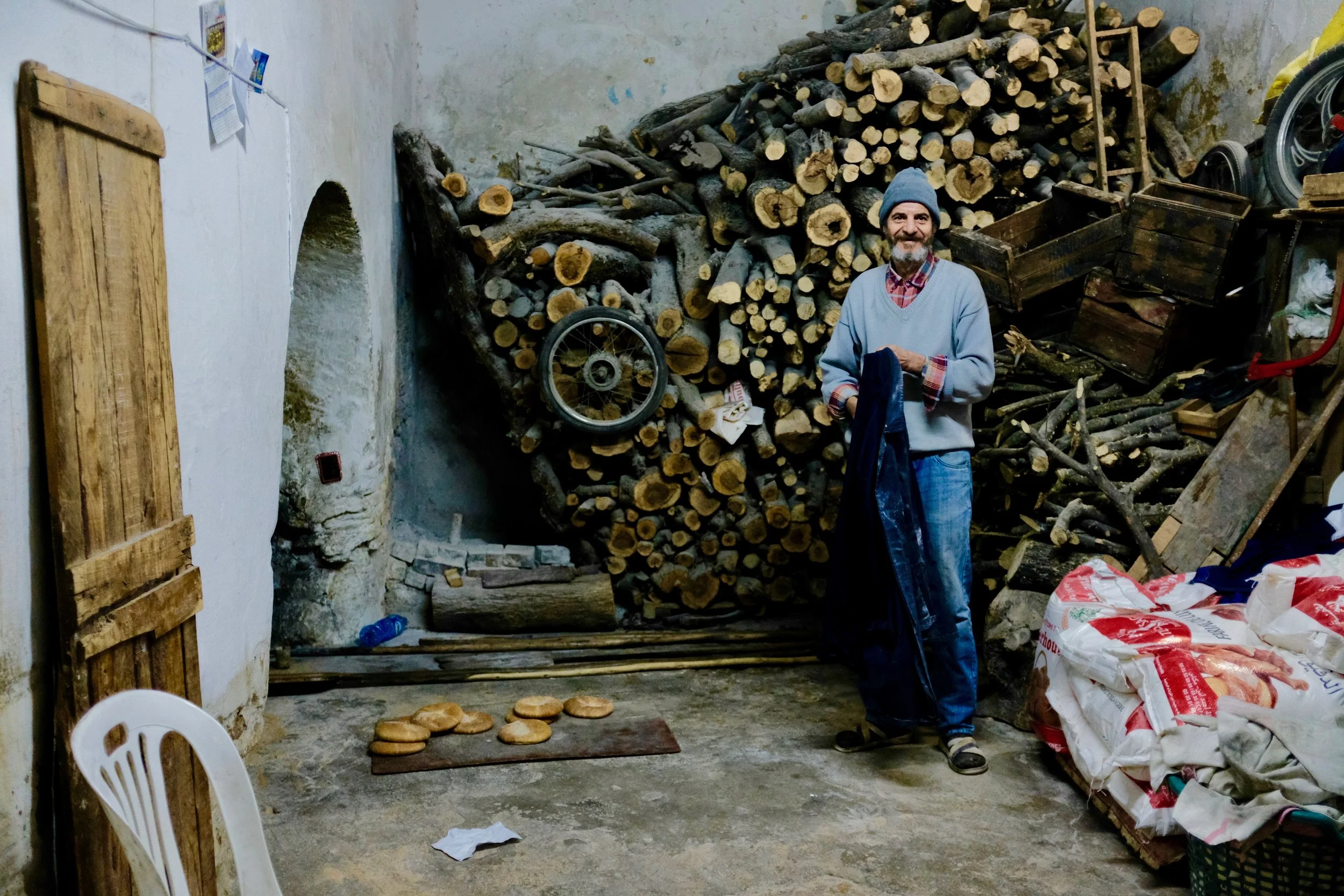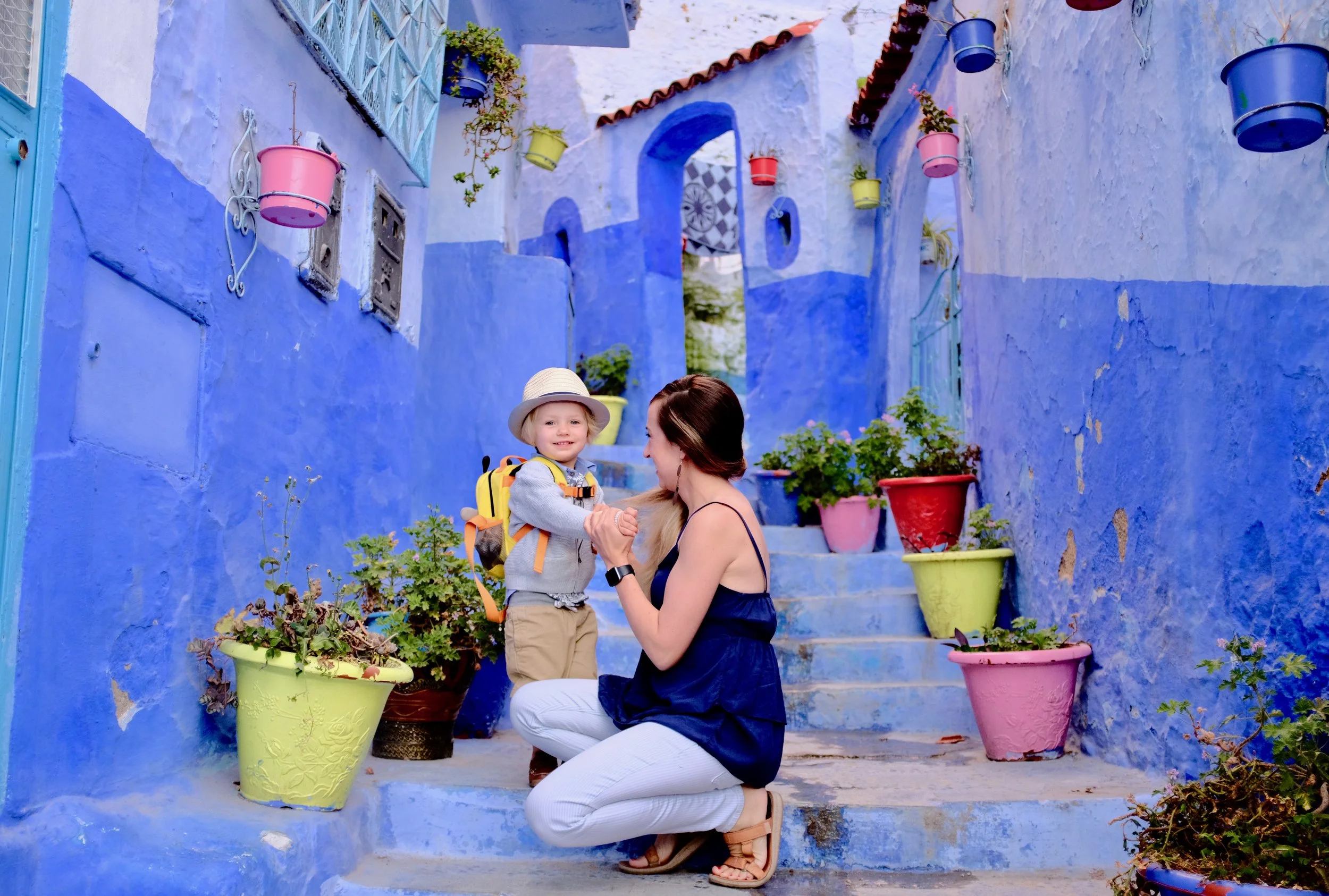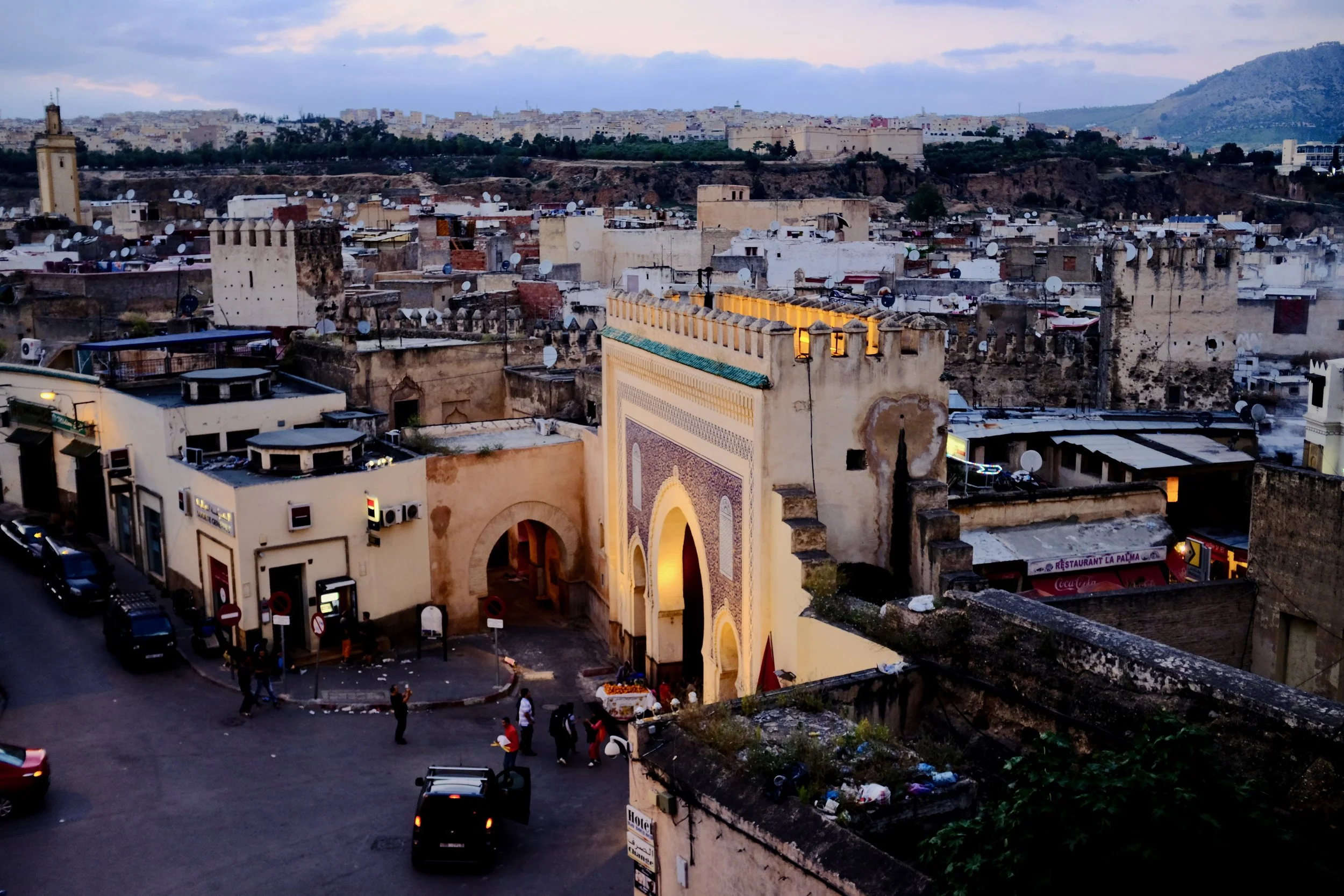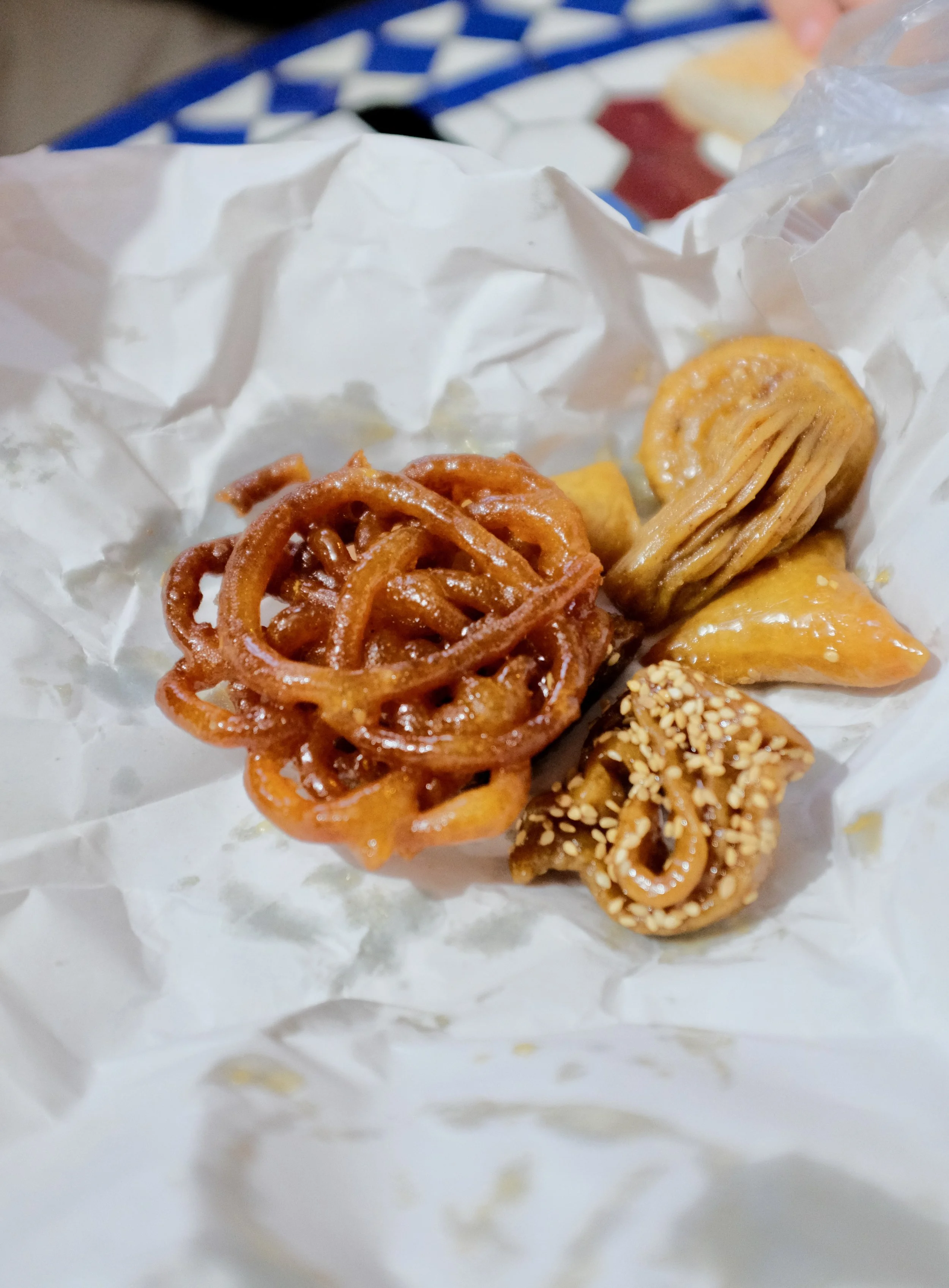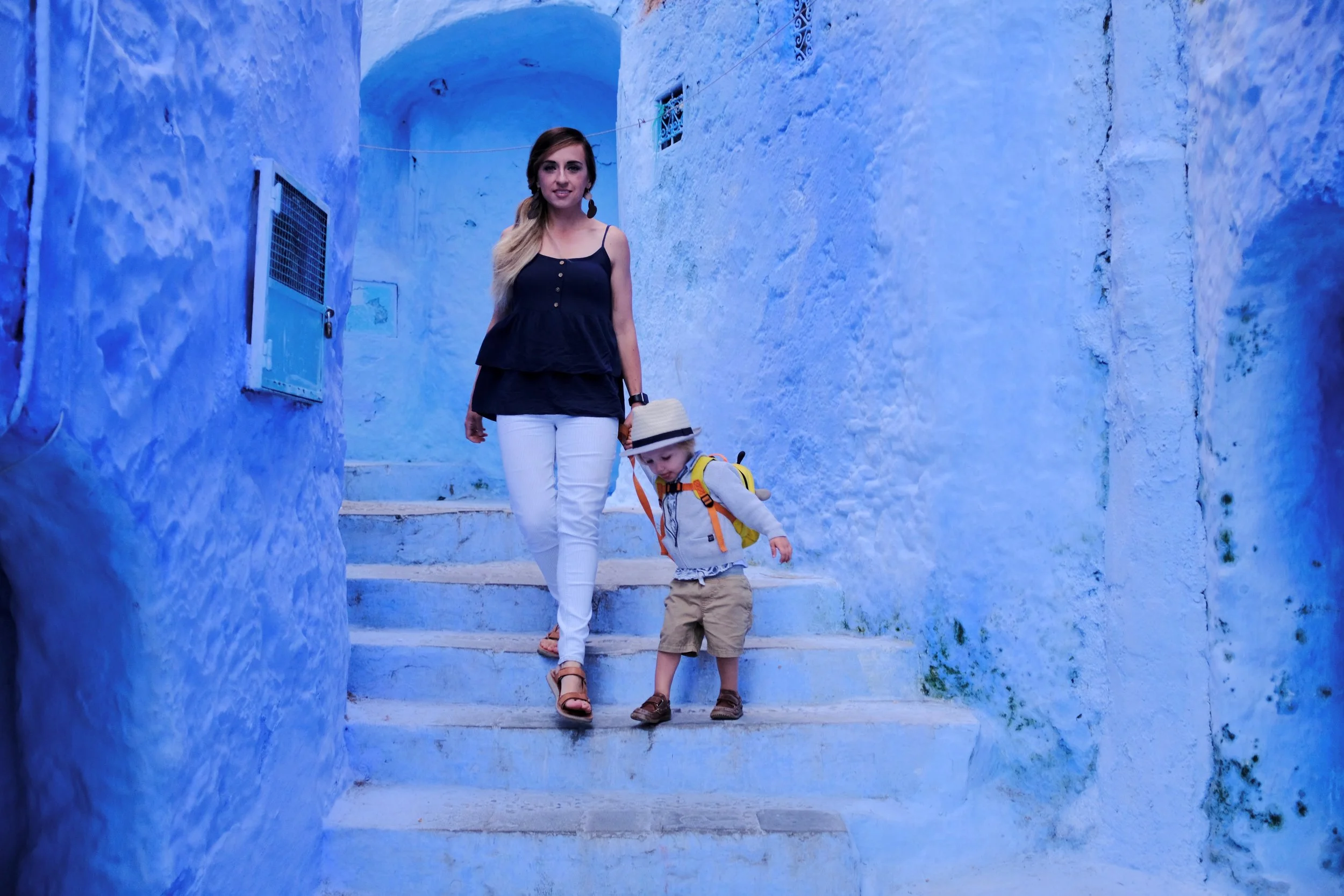Moroccan Food – What to Eat and Drink When You Visit Morocco
I TRAVEL FOR THE FOOD. Ok! I said it. I LOVE FOOD. I really do. I get so much joy out of trying new foods when I travel. I love learning about new cultures and people through eating and cooking their food. The food of a city tells about the place in more ways than we realize. Each recipe has a story behind it, some even passed down for generations. All the ingredients are found and grown by the people and then created into something beautiful to represent their culture. I really feel like, “The best way to know a city is to eat it.” That’s why I call myself the City Nibbler. It’s a title that I’m proud of.
Fez, Morocco, eating at Nagham Cafe.
The Drinks
Moroccan Mint Tea
Let’s start out with the tea, something that you’ll become very acquainted with by the time you leave Morocco. When you visit Morocco, be prepared to drink a lot of Moroccan mint tea. The Moroccans drink it all the time- breakfast, lunch, dinner, and many times in between. Whenever we arrived somewhere new, we were given tea. When we checked into our hotel, we were greeted with some tea. When we checked out of our hotel, we were given some tea. As we ate every meal, we were always offered tea. When we sat down to visit with people and look at their shops, they gave us tea. It was 4+ times a day that I found myself with a cup of Moroccan mint tea in my hand. And, I am not complaining about it! I think they drink it so much not only because it is so delicious, but because it is a safe way to hydrate with surety that the water is clean from it being boiled. You can’t drink the water in Morocco, so for thirsty tourists, this is the way to stay hydrated to avoid the food poisoning. I grew to love the tea when I was there. They use fresh spearmint leaves and green tea powder to make this yummy drink. They always ask you if you want it sweetened or unsweetened, and of course I prefer it sweetened. Who doesn’t want a little sugar in their tea? And they always bring a bowl of sugar cubes if you need a little more sweetness.
Jimmy took it upon himself to be the sugar cube distributer and inserter. For some reason he was so entertained when putting the sugar cubes into the cups. Sometimes he would sneak more in when we weren’t looking. We drank some pretty sweet tea at one point! But seriously, there is just something so delicious about hot fresh mint tea. The stainless steel teapots that they serve it in is so Moroccan, usually along side of little glass cups with a gold engraving along the edge. I love how they pour the tea from the teapot into the glasses. They make a big show of it, holding the teapot up high, away from the cup, so the stream of tea is very visible when it comes out and falls into the glass. It is a gorgeous tradition that is so Moroccan and I love it.
Jimmy and Nate enjoying some tea and sweets after checking into our hotel in Moulay Idriss.
Freshly Squeezed Orange Juice
Everywhere that you go in Morocco, there are people selling freshly squeezed orange juice. Oranges grow very well there, so they are able to make large amounts of juice very easily and from fresh oranges. It’s funny how in America freshly squeezed orange juice is a luxury, with the cost being at a premium, maybe $7 a glass. But in Morocco, the freshly squeezed orange juice is almost the same price as bottled water, or even cheaper sometimes. We paid 50 cents a glass a lot of places! So cheap! The only thing that was a little unappetizing, is that when visiting Marrakesh about five years back, we saw that the people selling orange juice were reusing old straws between customers, not washing them or disposing of them after each use. That left a sour taste in my mouth, but hey, that’s Morocco for you I guess. You never know what’s going to happen and that is part of the fun. Nate and I drank so much orange juice both times visiting Morocco, it was nuts. It’s just so good, so cheap, so refreshing, that it is hard to pass up. And like the tea, the orange juice hydrated us, giving us a substitute for the bad water.
Fez, Morocco
Don’t Drink the Water!
Beware of the water in Morocco. Don’t drink it! Be very careful and cautious of it or else you might end up sick for your whole trip. Besides not drinking it, make sure to brush your teeth with bottled water, wash your fruit with bottled water, and anything else that you use water for that might get into your body. Showering or washing your face with the water is fine, just don’t ingest it. Hydrate with bottled water only and even then, be extra cautious. We had an experience where we bought bottled water at a local market. We guzzled both bottles because we were so thirsty in the 100+ degree weather. After we drank it, we noticed that one of the bottle’s lids had been very carefully cut out with a sharp razor and opened on the top, with the clean water discarded and regular water put in. We were horrified and hoped that we wouldn’t have to suffer any negative effects. We ended up lucking out that time, but just take extra caution and examine everything before you eat or drink it. You can’t trust people in Morocco, some, but not many.
The Food
Moroccan Breakfast
Breakfast in Morocco is delicious but very carb heavy. Maybe that’s why it is so delicious! You’ll always receive a glass of freshly squeezed orange juice as well as a choice of hot Moroccan mint tea or coffee. Expect an assortment of different homemade bread items – spongy flat Moroccan pancakes called, “baghrir”, cornbread pucks called, “harcha,” little doughnuts, traditional brown bread, and my all time favorite breakfast menu item, “msemen” or “rghaif”- a flaky, chewy, and slightly crispy, Moroccan pancake or flatbread. They come most often just plain (perfect for spreading your favorite jam on) or stuffed with chilis and cheese for a more savory treat. Along with that hefty carb load comes an assortment of different condiments to eat with it like local honey, all kinds of jam, olive oil, butter, and goat cheese.
Don’t even get me started on the goat cheese. You haven't tried goat cheese until you’ve tried fresh Moroccan goat cheese. It is the best and something that the country is famous for. You’ll be eating your goat cheese on your bread and see some goats climbing a nearby hill, and it makes you realize just how fresh the goat cheese that you’re eating really is. There are a lot of goats in Morocco. These goats produce goat milk that is then turned into incredibly fresh goat cheese. Local food products really are the best.
Now that I’ve covered the important topic of goat cheese. . . let’s get back to the Moroccan breakfast. Often times you’ll get a bowl of olives on the side, which at first I thought was strange. Eating olives for breakfast? It eventually grew on me. (Probably from living in Spain where olives were everywhere!) If you’re dining at a fancier hotel then expect some eggs of some kind, a bowl of fresh yogurt and granola, and some perfectly ripe fruit. Of course every restaurant, every hotel, and every city in Morocco will be slightly different in what they serve you for breakfast, but for the most part, it will be very similar if not exactly these types of menu items. Deiish!
Fancy Moroccan Breakfast in Chefchaouen.
Casual Moroccan Breakfast in Tétouan.
Moroccan Lunch and Dinner
Appetizers
Lunch and dinner are very similar meals in Morocco as far as what you will eat. A meal most likely comes with three courses. The appetizer portion is really fun with a big spread of small little dishes to taste. They serve a bunch of different bean and vegetable salads, marinated and pickled veggies, olives, fried potato fritters, tabbouleh salad, and a soup called, Harira- a tomato based soup with lentils and meat. Jimmy shockingly loved the soup and survived on basically only this for the majority of our trip. Kids! And of course the appetizer round, as well as every meal, always comes with a basket of the traditional brown bread. The variety of this appetizer round varies greatly, but the flavors and ingredients are all quite similar.
Appetizer Spread
Main Dish
I love ALL types of food and cuisines (with the exception of seafood. . . I’m still trying to love that one), but I have my favorites. Moroccan food definitely isn’t one of them. I love Moroccan food for the first few days of a trip to Morocco, and then I am ready to eat something different. I think it lacks in variety, spice, and flavor. It’s a little bland and maybe a tad boring, with a lot of repetition. But it’s definitely fun to eat Moroccan food when you’re in Morocco! The mint tea on the other hand, I could never tire of.
If you lean towards eating vegetarian then you’ll appreciate the Moroccan cuisine. It is very healthful and packed full of steamed vegetables. Every menu typically has several vegetarian dishes listed on it. That aspect of Moroccan food is something that I love. I am not fully vegetarian by any means, but I do enjoy eating vegetarian food. I am one of those weird people that actually likes the taste of vegetables. I know. . . weird!
The main dish for lunch or dinner is always very similar no matter what restaurant you dine at. It is the quality of the food that changes from place to place, not the description of the menu items or the flavors. All Moroccan restaurants have practically the same things on the menu. The choices come with what type of meat that you want, usually chicken, beef, or kefta (seasoned ground meat) and if you want veggies with it or not.
The menu typically looks something like this-
Tajine with Meat and Veggies
Couscous with Meat and/or Veggies
Pastillas Stuffed with Chicken or Veggies
The tajine is the most traditional way of cooking Moroccan food. A tajine is a little clay pot with a lid on top, a traditional Moroccan handicraft that is made and sold in Morocco. We watched tajines being made in Tétouan, and it was quite the process from start to finish. It is cooked on the fire with the food enclosed, almost like a slow cooker, until the meat is falling off the bone and the veggies are perfectly tender. The food isn’t just cooked in a tajine but also served in a tajine. The second traditional menu item, couscous with meat and/or veggies, is always a safe bet, but I find that it is often times lacking in flavor and needs salt. I sound so American. My favorite of the three menu items, and the one that I tend to order the most are the pastillas. Pastillas are a savory pastry made from fillo dough that is stuffed either with chicken, dates and almonds, or an assortment of veggies. The chicken pastilla is often sprinkled with a dash of cinnamon on top, making it a great flavor combination of sweet and savory. Occasionally there is a lemon chicken tajine dish on the menu changing up the flavor of the typical tajine dish. Often times for lunch or for more casual street food, you will find grilled meat and veggie skewers. It is still the same ingredients but just cooked differently. Moroccans aren’t big on variety.
Tajines- a Morocan kitchen appliance traditionally used to cook meat and vegetables.
Pastilla- a traditional Moroccan savory pastry stuffed with meat or veggies.
Lunch of meat skewers, french fries, chicken pastilla, and Coke at The Aladdin restaurant in Chefchaouen.
Pizza Detour
Our last night in Chefchaouen, we were really craving something besides Moroccan food. I just wanted something cheesy, buttery- really just something very bad for me. Sometimes I can only take healthy for so long. While scouting out restaurants, we came across a pizza place called, Mandala Pizzeria. The reviews seemed good enough, so we went! It was packed full of tourists (like any local Moroccans would eat pizza) and we had a great time. The pizza wasn’t the best pizza by any means, mediocre by American standards, but man! It sure tasted good that night! To eat melted greasy cheese again! We were shocked to see that they offered pork products on the menu since Morocco is a strict Muslim country, and traditionally Muslims don’t eat pork. I guess they cater to the wishes and desires of the tourists. You better believe that we had pork on our pizza that night! Yum!
Moroccan Pizza from Mandala Pizzeria in Chefchaouen, Morocco.
Moroccan Dessert
Moroccans have very few dessert options. They aren’t like say France that makes the best desserts that I’ve ever tasted. If you’re in Morocco and you have a sweet tooth, these are your dessert options. The traditional Moroccan pastries that I’ve blogged about here called, “shebakia,” are really good with the honey glaze and chewy texture. We ate way too many of them on our last trip to Morocco. Besides the pastries, there are other types of shortbread cookies and nougats that are popular. Every restaurant also always serves a plate of sliced oranges with fresh mint and slivered dates on top, sprinkled with cinnamon. It is actually very refreshing and a great way to end the meal. And, there is always the option of drinking more sweetened mint tea! There were a couple of nights that we were craving something American for dessert, like ice cream, so we opted for the small grocery store that sold individual packaged ice cream bars. It is always fun to try new grocery store products within different countries and see how they differ.
Jimmy and Nate searching for the best Moroccan pastries in Fez, Morocco.
Have you eaten Moroccan food? What are your thoughts about the cuisine? I’d love to chat Moroccan food with you in the comments below!

